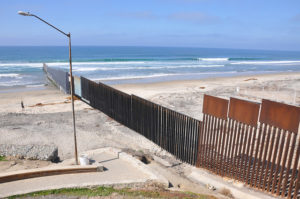 On day five of his Administration, January 25, 2017, President Donald Trump issued his first executive order on immigration, titled, Border Security and Immigration Enforcement Improvements. It prioritizes the detention and removal of unauthorized immigrants apprehended at the U.S.-Mexico border.
On day five of his Administration, January 25, 2017, President Donald Trump issued his first executive order on immigration, titled, Border Security and Immigration Enforcement Improvements. It prioritizes the detention and removal of unauthorized immigrants apprehended at the U.S.-Mexico border.
Here is a description of Trump’s executive order on border security and immigration enforcement, including the potential effects and impact:
Authority: In the order, Trump cites to the Constitution and federal laws, such as the Immigration & Nationality Act (INA), the Secure Fence Act of 2006, and the Illegal Immigration Reform and Immigrant Responsibility Act of 1996, as grounds for his presidential authority.
The president may set the policy and practices of immigration agencies and officials, in compliance with federal law set by Congress and the U.S. Constitution.
Purpose: The order directs departments and agencies to “deploy all lawful means to secure the Nation’s southern border, to prevent further illegal immigration into the United States, and to repatriate illegal aliens swiftly, consistently, and humanely.”
Policy Highlights:
1. Physical Wall. The executive order instructs the Secretary of Homeland Security to take steps to immediately plan, design and construct a physical wall along the southern border. The Secretary must identify and allocate federal funds for planning, designing and constructing the wall.
“Wall” means “a contiguous, physical wall or other similarly secure, contiguous, and impassable physical barrier.” The “southern border” means “contiguous land border between the United States and Mexico, including all points of entry.”
2. Detention Facilities. The executive order instructs the Secretary to allocate resources to immediately construct, operate, control, or establish contracts to construct, operate or control facilities to detain aliens at or near the land border with Mexico. The Secretary shall immediately assign asylum officers and immigration judges to detention facilities for the purpose of conducting reasonable fear determinations and removal proceedings, respectively.
3. Detention for Illegal Entry (End “Catch-and-Release”). The executive order instructs the Secretary to take immediate, appropriate actions to ensure the detention of aliens apprehended for violating immigration law, pending the outcome of their removal proceedings or their removal from the U.S. The Secretary shall issue new policy guidance to all Department of Homeland Security personnel on detention use, including the termination of “catch and release,” which involves persons being released in the U.S. shortly after their apprehension, and while their removal proceedings are pending.
4. Additional Border Patrol Agents. The executive order instructs the Secretary to take appropriate action to hire 5,000 additional Border Patrol agents, and ensure they are assigned to duty as soon as is practicable.
5. Foreign Aid Reporting. The executive order directs all executive departments and agencies to quantify federal aid or assistance to the Government of Mexico on an annual basis for the past 5 years.
6. Federal-State Agreements. The executive order instructs the Secretary to immediately engage with the Governors of the States, as well as local officials, to enter into INA 287(g) agreements. This allows for State and local law enforcement officials to perform functions of the immigration officers in relation to the investigation, apprehension , or detention of aliens in the United States under the Secretary’s direction and supervision.
7. Parole, Asylum, and Removal. The executive order instructs the Secretary to take immediate, appropriate action to ensure the parole and asylum provisions of immigration law are not exploited to prevent the removal of otherwise removable aliens.
8. Priority Enforcement. The executive order instructs the Attorney General to establish prosecution guidelines and allocate resources to ensure federal prosecutors give high priority to prosecutions of offenses connected to the southern border.
Effects and Impact:
1. Building the wall
The estimated cost of building the wall is at least $10 billion. During his election campaign, Trump stated Mexico will pay for it. But his executive order calls for the allocation of federal funds to plan, design and construct the wall. Congress must approve funding for any new physical barrier along the southern border. This means American taxpayers will front the cost for the wall.
Trump says Mexico will pay the money back later. His Administration suggested imposing a 20% tax on goods imported from Mexico to pay for the wall. But experts say this will lead to higher prices for American consumers, result in trade wars, and jeopardize U.S. jobs.
Another idea floated by the Administration is seizing or taxing remittance payments from immigrants sending money earned in the U.S. (their country of residence) to their families in Mexico (their native country). Trump has said the USA Patriot Act anti-terrorism law may be used to accomplish this feat, but such an action will likely be met with legal battles, logistical obstacles, and economic drawbacks.
Between 2000 and 2010, U.S. taxpayers spent $90 billion on border security. The costs involve deploying National Guard troops to the border, paying U.S. Customs and Border Protection (CBP) agents, building barriers, employing drug-sniffing dogs, and using predator drones.
In 2006, under the Bush Administration, Boeing and other companies were awarded a federal contract, named Secure Border Initiative Net (SBInet), to build a high-tech, “virtual fence” along the southwest border. Most of the 2,000-mile border between Mexico and the U.S includes desert plains, steep hills and other natural barriers that are hard to cross. At the time, about 88 miles of physical fencing existed and the U.S. government planned to increase the physical fences to 370 miles by the end of the following year.
The Obama Administration embraced SBInet, but cancelled the project in 2011, following mounting questions from Congress regarding feasibility, viability, cost and effectiveness. By that point, about $1 billion had been spent.
Skepticism concerning Trump’s proposed wall is warranted. John Kelly, who was recently sworn in as Secretary of Homeland Security, said a physical barrier is not enough. In his confirmation hearing, he stated, “If you build a wall, you would still have to back that wall up with patrolling by human beings, by sensors, by observation devices.”
2. Increasing Detentions and Expedited Removals
Enormous amounts of manpower, resources, and technology are already dedicated to securing the nation’s borders. In 2014, the number of Border Patrol agents grew to nearly 21,000, over a 500% increase from 1992 when there were about 4,000 agents.
In July 2006, then-Secretary of Homeland Security, Michael Chertoff, announced the end of the”catch and release” policy. Since then, the Department of Homeland Security (DHS) began detaining more individuals while they wait for their immigration court dates. On average, in 2006, DHS detained 21,450 people on a daily basis, compared to over 40,000 this year.
DHS also increased the issuance of expedited removal orders to persons caught at the border, rather than allow them to return without the legal consequences of a removal. In 2014, DHS removed 414,481 persons, compared to 280,974 persons in 2006.
Trump’s executive order aims to increase the size of the enforcement agencies, create more detention facilities for persons apprehended along the southern border, and end “catch and release.”
Although the “catch and release” policy ended under the Bush Administration, the Obama Administration issued a Policy Memorandum on the apprehension, detention and removal or undocumented immigrants, which some labeled as “catch and release 2.0”. The policy divided enforcement priorities into three general categories: Priority 1: Aliens who pose a threat to national security, border security, or public safety. Priority 2: Aliens who are misdemeanants and new immigration violators. Priority 3: All other immigration violators.
The Policy Memorandum instructed the agencies to focus on priority one and priority two offenders, instead of wasting resources on arresting and detaining priority three offenders. Because Trump’s executive order does not make these distinctions, it gives immigration enforcement agents more freedom to apply the detention and expedited removal process to all persons who they find ineligible for relief, particularly those apprehended at the border.
Federal funds must be allocated to operate detention facilities and detain hundreds of thousands of immigrants each year. The use of detention facilities is a very costly way to deter illegal crossings or other immigration violations. More affordable alternatives include parole/release on own recognizance, bonds, regular check-ins with immigration agents, regular home visits and check-ins, telephonic monitoring, and electronic ankle bracelet monitoring.
The executive order, which claims abuse of parole and asylum provisions, could also result in due process issues for asylum-seeking families fleeing to the border. This includes women and children from the Northern Triangle (Honduras, Guatemala and El Salvador) with credible asylum claims. Human rights groups and immigration advocates have raised concerns about detaining individuals escaping violence and persecution in their home countries. There are more humane and cost-effective alternatives to detention.
3. Deputizing State and Local Law Enforcement Officers to Perform the Duties of Federal Immigration Agents
Section 287(g) of the INA allows delegation of immigration authority to state and local law enforcement officers. The 287(g) program permits a state or local law enforcement entity to partner with U.S. Immigration & Customs Enforcement (ICE), under a joint Memorandum of Agreement, to enforce federal immigration law in their jurisdiction.
The 287(g) program was criticized for damaging public safety, being prone to racial profiling, and lacking oversight. In 2009, ICE revised the 287(g) program to prioritize the arrest and detention of undocumented immigrants with criminal histories. In a December 2012 news release, ICE announced it would not renew any of its agreements with state and local law enforcement agencies that operate task forces under the 287(g) program.
At that point, ICE concluded that other enforcement programs, including Secure Communities, are a more efficient use of resources for focusing on priority cases. Introduced in 2008, Secure Communities was a DHS program designed to identify immigrants in U.S. jails who are removable under immigration law. Participating jails sent the arrestee’s fingerprints not only to criminal databases, but also to immigration databases. No local law enforcement agencies were deputized to enforce immigration laws and ICE had only a technological presence in jails and prisons.
In November 2014, then-Secretary of Homeland Security, Jeh Johnson, issued a memorandum discontinuing the Secure Communities program, and replacing it with the Priority Enforcement Program to focus on convicted criminals and others who pose a danger to public safety. The memorandum instructed ICE to replace requests for detention (i.e., requests that an agency hold an individual beyond the point at which they would otherwise be released) with requests for notification (i.e. , requests that state or local law enforcement notify ICE of a pending release during the time that person is otherwise in custody under state or local authority).
Trump’s executive order promises to revive the 287(g) program, which allows states and localities to engage in immigration enforcement to supplement federal efforts. This practice can create mistrust of local law enforcement and involve the use of limited resources to detain and subsequently remove persons with only traffic stops or minor infractions.
With over 500,000 removal cases pending in fiscal year 2017, and immigrants facing years long delays before a judge makes a final decision on their case, the immigration court system is already heavily backlogged. 287(g) agreements fail to prioritize dangerous criminals over undocumented immigrants who pose no threat to public safety. They also tend to reduce cooperation from immigrant communities, which is crucial to preventing and investigating crimes.
Conclusion
Building a wall, increasing detention, and deputizing state and local law enforcement officers to enforce immigration law are consistent with Trump’s campaign promises. But they could very well backfire in the form of wasted taxpayers’ money, squandering of limited resources, unbearable pressure on the already backlogged immigration court system, and reduced cooperation between immigrant communities and their state and local law enforcement entities.
For information on Trump’s other executive orders on immigration, read:
This article provides general information only. It is based on law, regulations and policy that are subject to change. Do not consider it as legal advice for any individual case or situation. Each legal case is different and case examples do not constitute a prediction or guarantee of success or failure in any other case. The sharing or receipt of this information does not create an attorney-client relationship.
Photo by: Clive Darra

 Donald Trump’s Administration will begin when Barack Obama’s ends on January 20, 2017. The risk of deportation is expected to get higher for unauthorized immigrants, particularly those with illegal entries and certain criminal histories. A Trump Administration could also repeal Obama’s Deferred Action for Childhood Arrivals Program (DACA) and set the stage for H-1B (professional worker) visa reform.
Donald Trump’s Administration will begin when Barack Obama’s ends on January 20, 2017. The risk of deportation is expected to get higher for unauthorized immigrants, particularly those with illegal entries and certain criminal histories. A Trump Administration could also repeal Obama’s Deferred Action for Childhood Arrivals Program (DACA) and set the stage for H-1B (professional worker) visa reform.
 When you present yourself for admission into the U.S. at a designated port of entry (e.g. international airport), you may be denied entry and issued an expedited removal order if the U.S. Customs & Border Protection (CBP) finds you inadmissible on certain grounds.
When you present yourself for admission into the U.S. at a designated port of entry (e.g. international airport), you may be denied entry and issued an expedited removal order if the U.S. Customs & Border Protection (CBP) finds you inadmissible on certain grounds. Back in November 2014, the Obama Administration proposed an expansion of the Form I-601A, Provisional Unlawful Presence Waiver, to a larger pool of immigrant visa applicants.
Back in November 2014, the Obama Administration proposed an expansion of the Form I-601A, Provisional Unlawful Presence Waiver, to a larger pool of immigrant visa applicants.